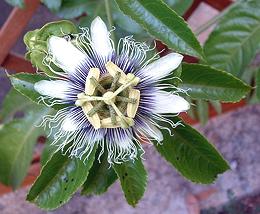 [Maracujá (Portuguese); Maracuyá, Parcha (Spanish);
Grenadille, Fruit de la Passion (French); Liliko'i (Hawaiian);
Mburukuja (Guarani); Markisa (Indonesia); Saowarot (Thai); Chanh Day
(Viet); Granadilla purple, Guavadilla yellow (South
Africa); Chinola (Dominican Republic); Passiflora edulis and
others of Family Passifloraceae]
[Maracujá (Portuguese); Maracuyá, Parcha (Spanish);
Grenadille, Fruit de la Passion (French); Liliko'i (Hawaiian);
Mburukuja (Guarani); Markisa (Indonesia); Saowarot (Thai); Chanh Day
(Viet); Granadilla purple, Guavadilla yellow (South
Africa); Chinola (Dominican Republic); Passiflora edulis and
others of Family Passifloraceae]
These perennial vines are native to Brazil, Paraguay, Uruguay, and northern Argentina. They are now grown in tropical and subtropical regions worldwide, including California and Florida. The fruits are eaten fresh in some regions, but their main uses are for juice, used in many beverages (alcoholic and non-alcoholic alike) and in desserts. There are two varieties, the normal purple, and the much larger (up to grapefruit size) yellow var flavicarpa which is not as popular due to often being more acidic and less aromatic. The yellow is sometimes used as vigorous rootstock with the purple grafted on.
The name "Passion Flower" comes from the practice of Catholic
missionaries using the characteristics of the flower to enumerate
features of the Passion (crucifixion) of the Christ to natives they
were trying to convert.
Photo by Anne97432 distributed under license
Creative Commons
Attribution-ShareAlike v3.0 Unported.
More on Violet Family
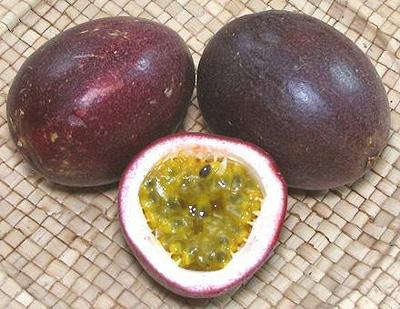 Passiflora edulis]
Passiflora edulis]
Varieties characteristic of inland regions produce dark purple fruit about about 1 inch diameter, while varieties grown in coastal regions may be considerably larger. The photo specimens, grown in USA, were up to 3 inches long, 2-3/8 inches diameter, and 2.5 ounces. Yield was 60% with seeds - sorry, I ate the seeds along with the pulp so I can't give you a yield for just the pulp. The shell and enclosed pith are not particularly edible, but the pulp was attractively sweet-tart, aromatic and flavorful, a bit more tart than tamarind. At the going price, I'd recommend just cutting them in half and eating the pulp with a spoon, rather than diluting it in some recipe.
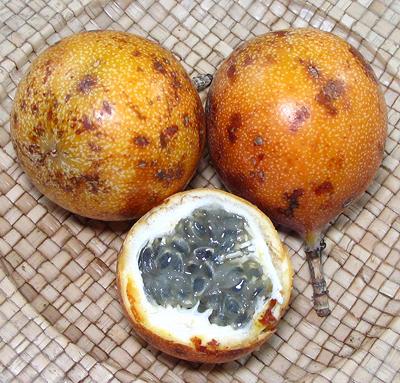 [Passiflora edulis var flavicarpa]
[Passiflora edulis var flavicarpa]
Yellow Passion Fruits are larger than the purple, and are generally more tart, but degree of tartness varies with cultivar and soil. The photo specimens were up to 2.7 inches diameter and 4.0 ounces, but some yellow cultivars can top 4 inches diameter. Yield was 55% with seeds - sorry, I ate the seeds along with the pulp so I can't give you a yield for just the pulp. The shell was not edible. The enclosed soft pith was edible, but had almost no flavor. The pulp was attractively sweet-tart, with an amazingly aromatic flavor. At the going price, I'd recommend just cutting them in half and eating the pulp with a spoon, rather than diluting it in some recipe. The flavor should be appreciated.
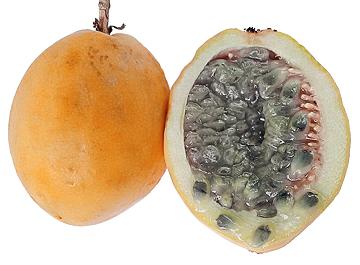 [Jamaican honeysuckle, Golden bellapple; Pomme liane (Martinique
Guadeloupe); Orange lilikoi (Hawaii); Passiflora laurifolia]
[Jamaican honeysuckle, Golden bellapple; Pomme liane (Martinique
Guadeloupe); Orange lilikoi (Hawaii); Passiflora laurifolia]
Water Lemon vines are native to the American Tropics but have spread to other tropical regions. They are considered invasives wherever they grow, but are restricted in range because they can not tolerate any frost. They are otherwise very tolerant, but grows best in slightly humid environments and like year-round ground moisture. Ripe fruits may be orange or green with longitudinal darker green stripes. They are up to 2 inches diameter and 3 inches long. The fruit pulp is flavorful and aromatic, but lacks the tartness of other edible Passion Fruit species. Photo by Filo Gèn' distributed under license Creative Commons Attribution-ShareAlike 4.0 International.
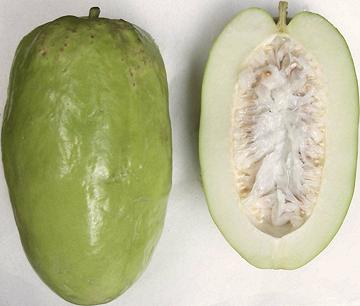 [Giant Granadilla, Barbadine (Trinidad); Grenadine (Haiti);
Giant Tumbo Passiflora quadrangularis]
[Giant Granadilla, Barbadine (Trinidad); Grenadine (Haiti);
Giant Tumbo Passiflora quadrangularis]
Badea vines are native to the American Tropics, and are cultivated in the Caribbean region and South America.They require a warm moist climate and can be damaged if temperatures fall below 50°F/10°C. Ripe fruits are green, and up to nearly 12 inches long. The fruit pulp is flavorful, aromatic, and lightly tart. Unlike other Passion Fruits, the thick pericarp surrounding the seed mass is also eaten, and immature fruits are cooked as vegetables. Leaves and roots have medicinal uses, but roots are toxic so caution is advised. Photo by Fibonacci distributed under license Creative Commons Attribution-ShareAlike 4.0 International, Attribution required .
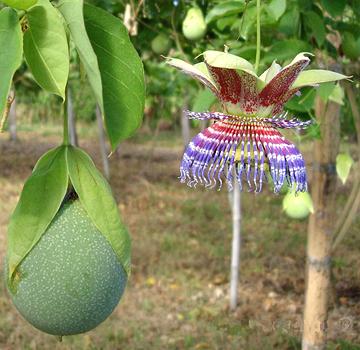 [Sweet Calabash, Conch Apple, Wild Purple Passionfruit, Sweet Cup;
Passiflora maliformis]
[Sweet Calabash, Conch Apple, Wild Purple Passionfruit, Sweet Cup;
Passiflora maliformis]
This tropical vine is native to the Caribbean, Central America and northern South America, and is cultivated in the Caribbean region. Fruits may be green, yellow or purple when ripe, and up to 1-3/4 inches diamter. The rind is much harder than with other Passion Fruits, but the pulp, light gray in color, is flavorful, aromatic, and lightly tart. It is used for beverages or eaten raw. This plant grows in warm, wet tropics and needs 61°F/16°C when flowering. Photo by John Ocampo, contributed to the Public Domain .